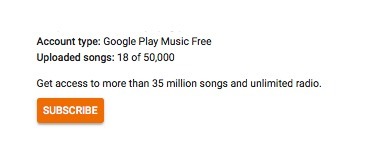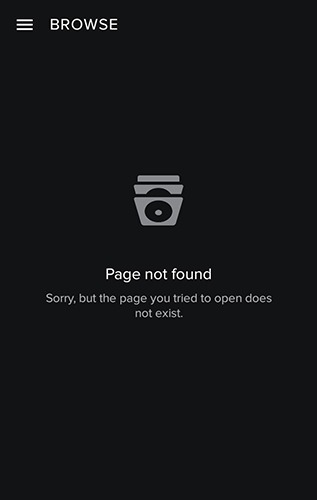I’m a long time music lover and listening to it is a big part of my daily routine. Whether it’s a blues tune on a cold rainy evening, some fast paced beats when cycling down a mountain or a post-rock instrumental rhythm for those times when I just need to gather my thoughts. I like discovering new music and I like having music around me.
Enter Spotify
Some two years ago I joined the rest of the world in switching to music streaming in favour of listening to MP3 files. I chose to go with the rising star at the time – Spotify – and quickly became happy with my decision.
I got used to it fast and it didn’t take long for Spotify to be my main source of music. It convinced me to switch to its paid plan and everything, all was good. Months had passed without me even launching my trusty foobar2000 on the laptop anymore, not when Spotify also had a Windows application (albeit web-based in a desktop wrapper). Spotify was the music player I would turn to both at home and on the go. Until it started coming between me and music.
Where’s my music?
After awhile I started noticing some behaviour that, let’s just say, wasn’t in any way helping me listen to my favourite music. When I started using the app on my Android phone – a Samsung Galaxy Nexus at the time – I would always have some music saved for offline mode. Heck, I still do this now, mainly because I don’t want to use up all my data to stream and also because I usually get stuck on some particular bands or genres for (at least) a few days. So I would just download some albums locally and listen to them whenever I wanted to without any network traffic.
Now imagine you are about to get on a plane. You have some music prepared to make the flight more bearable, it’s all saved as offline. You board the plane and get seated. You plug-in your ear buds, turn on Spotify and go to your music library. Its empty. The plane takes off.

I thought maybe it was because I had my data turned off and Spotify couldn’t tell what was in my library, but this thing happened more than a few times again and again in my daily commute to work and even at home. My offline music just disappeared both when I had data on and when I was connected to the Wi-Fi (like in the screenshot above). Spoof, magic!
After awhile I started storing some albums as MP3 files on my phone for whenever Spotify decided to pull off these kind of stunts. Since I would listen to them with Google Play Music, I ended up having two music apps, a main one and a backup.
Forever loading
Now the other times, when Spotify wasn’t messing with my offline music, it messed around with everything else. Most of the actions that should make this a great music streaming app have in fact made it almost completely unusable for me. No matter if I tried to view my library, browse music or open up an artist’s profile I would almost always be greeted by a never-ending loading screen.

And even when that screen eventually does load, it does so at a ridiculously slow pace. Just check out the last screen in the above image. Now sure, you could go ahead and say that my connection is bad or that my phone is just too slow but this wasn’t the case. It happened randomly on both data and different Wi-Fi networks. And as far as phone performance goes, my phone should have been more than enough to run the app. Since when do you need a flagship phone to listen to music?
Go online to see the menu
In all honesty though I should give credit where credit is due. Spotify did have its benefits and I think the feature that I found most useful was the “Discover” mode. While using Spotify I came across some amazing artists who were recommended to me based on other artists that I was following and listening to. I’d say Spotify’s suggestions nailed it about 8/10 times.
But listening to a recommended album isn’t good enough if I can’t check out the artists themselves and more of their work. Good thing Spotify allows me to do this by going to the artist’s profile. Or does it?

It was always a 50/50 chance that what you see in the image above would happen to me if I try to open up the menu for an album or song. How cool is that? Not very. Should I have used a little post-it to write down the artists and search for them later? Not that it would matter, most likely the search would’ve only shown me loading screens anyway (the search almost never worked on any of my phones).
Guess the recipients
When the menu did eventually pop-up and I wanted to use it to, let’s say, recommend an album to a friend I went for the “Send to…” option and proceeded to “Select Recipient” (as they labeled it). Problem is that I couldn’t actually select a recipient! I would start typing in a username but got no autocomplete whatsoever. Should I have known everyone’s username by heart?

Because of this little bug I often chose to avoid sharing stuff from my phone in favour of the desktop app, where this feature actually worked. But what happened when I was on the go and wanted to share music? Most often I didn’t end up doing it because by the time I got to my computer I had completely forgotten about it.
Epic collection, friend!
Although every app or service has its flaws, I sort of felt like Spotify was going for the golden medal in bug olympics. I mean it’s not like there is one perfect solution out there that caters to your every need. Nor should there be, otherwise you end up with something the likes of iTunes that does it all but masters none. Frustrating as these bugs were, I looked passed them and continued using the streaming service. This all changed when one day I couldn’t save anymore songs to my library:

It’s not a good experience to get such a notification without having any idea that there even was a song limit. Apparently I had reached the 10,000 marker for my collection. This limitation I found to be very annoying especially since I had a paid subscription. Why the limit? Here’s why:
We’ve recently reviewed this internally and at the moment we don’t have plans to extend the Your Music limit. The reason is because less than 1% of users reach it. The current limit ensures a great experience for 99% of users instead of an “OK” experience for 100%
I don’t know if there are any real technical reasons for the “OK” vs “great” experience that they are talking about but it’s good to know that instead of resolving their limitation issues they just left it like so. Interestingly enough Google Play Music doesn’t have such issues. In fact at the time this article was written they were offering 50,000 uploadable songs even for users on the free plan. A limit which was bumped up from 20,000 a year before. That’s 40k more songs than Spotify as actual MP3 files!

Of course people will have different opinions on the matter like comparing how it is to have 10k digital songs vs having them as CDs or cassettes. Because that’s how such services evolve, by comparing themselves to old or even obsolete media.
It’s not me, it’s you
After being fed up with how Spotify does things and seeing that even updates to their desktop app had started compromising the user experience big time, I decided it’s time we part ways. Now by this point I was already frustrated enough that I just wanted to get it over with so I was expecting a quick cancellation and I’d be on my way. If only things were so easy. From the subscription options in my Spotify account I proceeded with the cancellation and this is how “easy” it was to opt out:





What else is there?
When I cancelled Spotify last December I was already a few weeks into my trial run with Google Play Music so I pretty much knew what the complete switch would bring. I have to say, it has indeed come a long way since its launch in 2011 and there are a few things in particular which caught my attention:
- Music manager: uploading your own songs in bulk directly from your computer. With a limit of 50,000 songs you can easily make sure that your collection is complete and your music never leaves your side.
- Built-in Shazam: when searching for a song you can tap on “Identify what’s playing” in the app and it will listen to what’s playing around you and search for it in the Google Play Music database.
- Shortcut keys: with an extensive list of shortcut keys for the web player you can become a power user in no time. Just press Shift+? for the list of possible key combinations.
- Custom themes: personally I’m fine with the default light theme but if you don’t feel the same then you can always head over to userstyles.org where you can find more options.
- Family plan: the individual subscription works great for me but if you need more accounts then there’s also a group plan available for €14.99/month and from what I’ve seen people are very happy with it. Now this is especially interesting since for this price you could only get one extra member on Spotify:

Even so there are still a few areas in which Google falls short with its music streaming but at the rate they’re improving things I’m hoping to see these fixed sooner or later:
- Sharing with other users: instead of getting a link or sharing on Google+ users should also be able to simply share internally in Google Play Music.
- Bulk management: removing artists and albums in bulk from the library or downloads should be easier than going through the albums one by one.
- Desktop app: as much as Google loves their SPAs, having my music player lost somewhere with the rest of the Chrome tabs isn’t ideal. The mini music player does help, but only to some extent.
Conclusion
Just to be clear on where I stand, this post is only about my own personal experience with Spotify and it obviously doesn’t mean that this is how it works for everyone. If you’re happy with it then by all means just keep on using it. If not… well then you should research alternatives I suppose.
It’s worth mentioning though that while writing this article I had to reinstall Spotify on my Android phone to grab a couple of screenshots. Not only were all the bugs I mentioned above still present for me but even more so, the first screen I saw after signing into my account was this one:

If you’re in the same spot I was a few months ago and you’re thinking of switching teams then I recommend you give Google Play Music a try. They offer a one month free trial (same as most services) so you can make use of that to see if it’s to your liking. If not, then start looking for something else. Just drop me a line below if you find anything better, seriously!